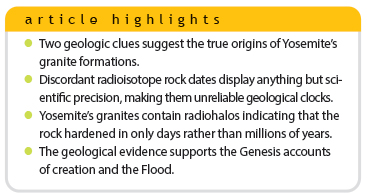 Yosemite National Park in California is a sure source of stunning scenery. It’s no wonder that American naturalist John Muir persuaded President Theodore Roosevelt to preserve Yosemite Valley.1 But how and when did this park’s dramatic peaks rise? Two clues in particular should clarify the origins of Yosemite’s mountain granites.
Yosemite National Park in California is a sure source of stunning scenery. It’s no wonder that American naturalist John Muir persuaded President Theodore Roosevelt to preserve Yosemite Valley.1 But how and when did this park’s dramatic peaks rise? Two clues in particular should clarify the origins of Yosemite’s mountain granites.

A Mental Setting
Before investigating this, one must first consider one’s beliefs—e.g., whether Noah’s Flood actually covered the earth—because they inevitably affect a person’s decision tree.3 Creation scientists treat the Bible’s report of Noah’s Flood as true, not just the account recorded in Genesis but also those by David (Psalm 29), Peter (2 Peter 3:5–6), and even Jesus (Matthew 24:37–38). Those who welcome this perspective recognize the geological effects of world-destroying water.

For example, geology shows that North America’s western edge suffered great stresses. Sediments were deposited, subducted, faulted, stretched, and compressed. Volcanoes spewed vast volumes of ash through great gashes in Earth’s crust into continent-covering water.4 One of the last western-edge geologic episodes occurred when molten material rose through Earth’s crust and quickly cooled. It was later uplifted and exposed by erosion, forming the Sierra Nevada mountain range in which the now-scenic Yosemite Valley rests.
The vast sedimentary layers and deformed rocks that flank the Sierras, plus countless deeply buried fossils, already point to past geologic processes that exceedingly surpassed today’s energy levels. In addition to water, the Flood involved tectonic, magmatic, and volcanic aspects, like those involved in the formation of the Sierras, that rearranged Earth’s entire surface in mere months.5 In contrast, conventional scientists reject the Flood outright—often without testing it against the rock and fossil evidence.
One similarity between Flood and anti-Flood models is the relative timing of geologic events. Both models agree that waterborne sediments blanketed the region first, after which the Sierras formed, which was then followed by an ice age. However, anti-Flood models reject evidence of youth, like that discussed below. But why? Those committed to evolution need to give natural processes enough time to evolve all plants and animals from a one-cell ancestor. So if these rocks show evidence of recent formation, which they do, then out goes evolution, forcing the Bible and its holy God into consideration.7
Inconsistent Dating
Our first origins-orienting clue comes from inconsistent radioisotope results. Conventional scientists performed radioisotope dating on Yosemite granites. One such method (uranium-lead) gave ages that ranged from 80 to 120 supposed million years.8
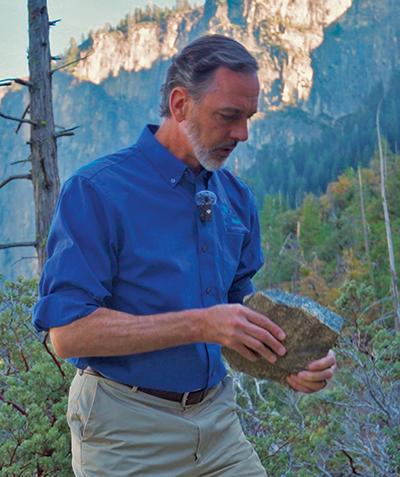
But are isotope-based ages like these reliable? Well, the dating methods do require workers to make unprovable assumptions.9 Plus, they have failed to accurately test rocks of known historic ages.10 And different techniques often give different ages for the same rock.11
The Sierras are no exception. One conventional geologist wrote about Sierra samples that “some potassium-argon hornblende [another mineral in granite] ages are inexplicably older than uranium-lead ages for the same rocks.”8 These inconsistencies suggest that isotope systems make poor clocks. The next example makes them seem even more meaningless.
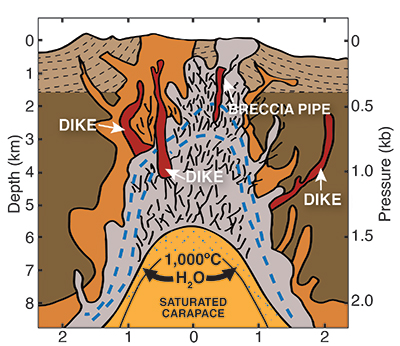
Granites have chemical signatures—like fingerprints. Granites that are quite similar from peak to peak came from the same magma source. Radioisotope ages for similarly sourced Yosemite granites called plutons suggest that it took 10 million years for them to form. However, in the researchers’ own words, “Simple thermal considerations preclude the possibility that a magma chamber the size of the Half Dome pluton could have existed as a liquid at shallow crustal depths for that long.”12 That magma would have cooled long before even one million years, let alone 10. One solution to this inconsistency is to replace isotope ages with more reliable sources.
Put a Ring on It
Microscopes reveal radiohalos in biotite from granites worldwide. Radiohalos look like dark, concentric rings. They form when a radioactive center emits energy and particles. Too much heat erases them, so they form when the granites are about 150°C.13 Each radioisotope leaves behind a characteristic ring pattern. The ICR Radioisotopes and the Age of the Earth (RATE) project sampled many granites for radiohalo analyses, including samples from six Yosemite locations.14
The RATE scientists often found polonium (Po) near uranium (U). U turns into Po as it decays to lead. Biotite mineral forms into sheets as magma cools and releases water. Therefore, the team reasoned that hot water carried Po between the crystal’s sheets away from its parent U. So what? Well, Po doesn’t last long. If these granites took more than 10 days to cool, then they would not have captured polonium radiohalos.13 If we go by what Po radiohalos say, then these granites formed not over millions of years but in mere days.15
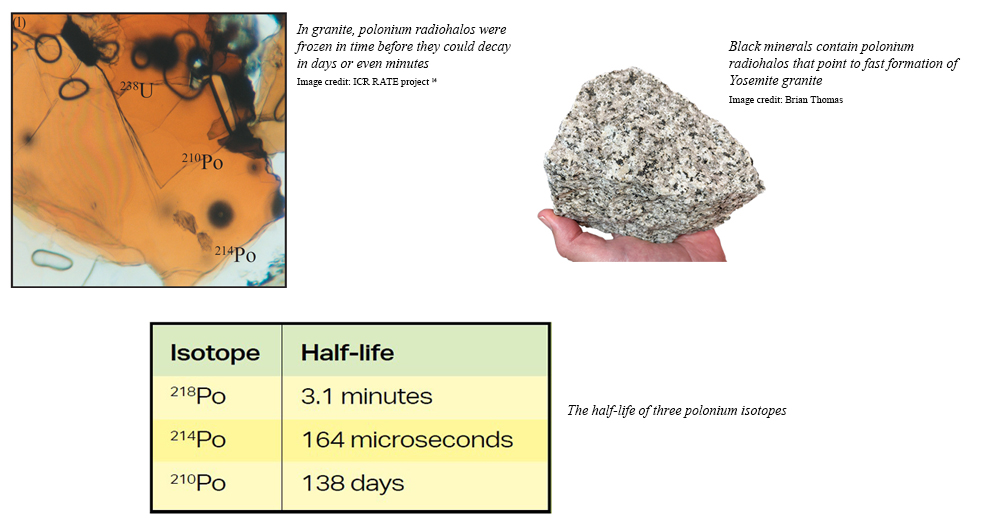
Conclusion
The two clues covered in this article have narrowed down the options for how quickly Yosemite’s granite mountains formed. First, radioisotope ages are too inconsistent in several ways to trust. Second, the existence of polonium radiohalos implies that granites cooled in days after all.
What does all this mean? When correctly interpreted, the geological evidence supports the Bible’s timeline of a recent creation and Flood. Since God got His history right, then we have more reason to trust His every word.
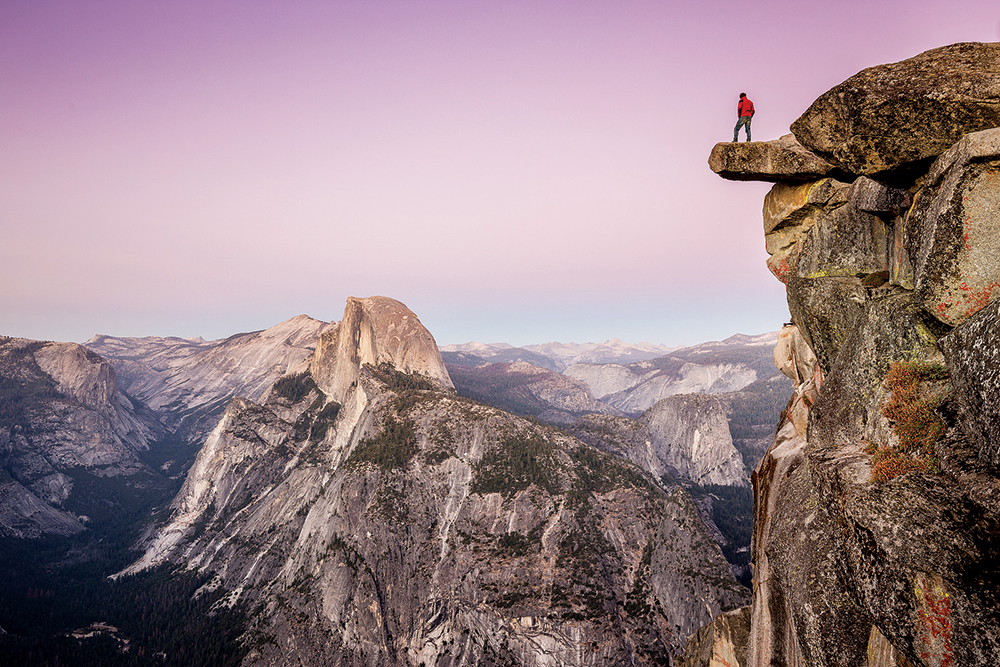
References
- The Yosemite Recession Bill, signed by President Roosevelt in June 1906, transferred guardianship of regions from the state of California to the federal government’s Yosemite National Park.
- To watch Creation on Location episodes and other ICR science videos, visit YouTube.com/@icrscience.
- By “decision tree” I mean everything pertaining to decision-making, including which research questions to ask, which models to employ, which results to emphasize, and what conclusions to draw.
- All that volcanism left behind the Independence dike swarm that extends for hundreds of miles across California’s southeastern deserts.
- Psalm 29 appears to give illustrations of global events from the Flood year, including leveled forests (v. 5), extensive volcanism (v. 7), and violent earthquakes (v. 8), with floodwater first and last. See Dr. Henry M. Morris’ notes on this in The Defender’s Study Bible free online at ICR.org/bible/psalm/29/.
- The DVD set Carved in Stone: A Creationist Road Trip Across America is available for purchase as a digital download. Visit ICR.org/store, enter code 1886 in the search bar, and click the download link at the bottom of the DVD description.
- Clarey, T. 2020. Carved in Stone: Geological Evidence of the Worldwide Flood. Dallas, TX: Institute for Creation Research.
- Bateman, P. C. 1992. Plutonism in the Central Part of the Sierra Nevada Batholith, California (Professional Paper 1483). Denver, CO: United States Geological Survey.
- The assumptions are untestable and so must be fabricated when converting isotope ratios into ages. Assumptions include (1) no process altered the isotope ratio other than radiodecay and (2) all daughter atoms came from radiodecay as opposed to having been in the melt before it cooled.
- For example, one study reported excessively old isotope ages for rocks of known ages. See Dalrymple, G. B. 1969. 40Ar/36Ar Analyses of Historic Lava Flows. Earth and Planetary Science Letters. 6 (1): 47–55.
- See Austin, S. A. 1988. Grand Canyon Lava Flows: A Survey of Isotope Dating Methods. Acts & Facts. 17 (4).
- Coleman, D. S., W. Gray, and A. F. Glazner. 2004. Rethinking the Emplacement and Evolution of Zoned Plutons: Geochronologic Evidence for Incremental Assembly of the Tuolumne Intrusive Suite, California. Geology. 32 (5): 433–436.
- Snelling, A. A. 2008. Catastrophic Granite Formation. Answers Research Journal. 1: 11–26.
- Snelling, A. A. 2005. Radiohalos in Granites: Evidence for Accelerated Nuclear Decay. In Radioisotopes and the Age of the Earth: Results of a Young-Earth Creationist Research Initiative. L. Vardiman, A. A. Snelling, and E. F. Chaffin, eds. Dallas, TX: Institute for Creation Research and Chino Valley, AZ: Creation Research Society.
- Another implication of Po radiohalos is that millions of years’ worth of U-decay at today’s slow rates must have occurred in mere minutes to generate enough Po to make radiohalos. See reference 12 for details.
Dr. Thomas is a research scientist at the Institute for Creation Research and earned his Ph.D. in paleobiochemistry from the University of Liverpool.













